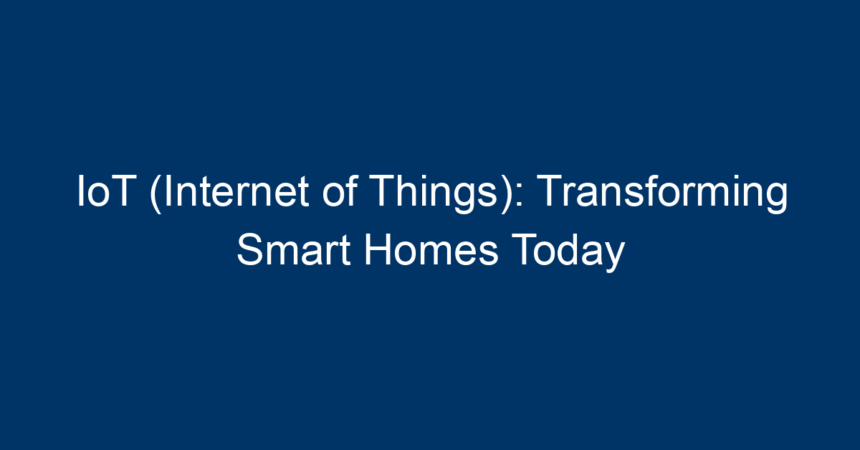In recent years, the concept of “smart homes” has shifted from futuristic fantasies to achievable realities, largely due to the incredible advancements in IoT (Internet of Things) technology. With the ability to connect everyday devices to the internet, IoT empowers homeowners to automate, monitor, and manage their living spaces from anywhere in the world. This complete guide will explore how IoT is redefining smart homes, enhancing convenience, security, and energy efficiency.
What is IoT (Internet of Things)?
The Internet of Things (IoT) refers to the interconnected network of devices that communicate and share data with one another via the internet. These devices, ranging from everyday appliances to sophisticated security systems, are embedded with sensors, software, and other technologies to facilitate real-time data exchange. As a result, IoT has revolutionized the way we interact with technology and our environments.
Key Features of IoT
-
Connectivity: At the heart of IoT is the ability of devices to connect and communicate with each other. This connectivity allows for seamless integration and functionality.
-
Automation: IoT devices can automate tasks, reducing the need for manual intervention and increasing efficiency.
-
Data Collection and Analysis: IoT devices continuously collect data, providing valuable insights for users.
-
Remote Control: Users can remotely monitor and control IoT devices through mobile applications or web platforms.
- Scalability: IoT systems can be easily scaled up or down, accommodating future technological advancements or changing user needs.
The Impact of IoT on Smart Homes
The integration of IoT technology into smart homes not only enhances convenience but also improves safety and energy efficiency. Here’s how:
1. Enhanced Home Automation
Home automation through IoT allows residents to control various aspects of their homes with simple voice commands or via mobile applications. From adjusting the thermostat to switching on lights, the possibilities are endless. Imagine arriving home after a long day to a well-lit, perfectly heated living room—all done automatically!
Popular Home Automation Devices
-
Smart Thermostats: Devices like the Nest Learning Thermostat can learn your habits, optimize heating and cooling, and help save on energy costs.
-
Smart Lighting: Brands like Philips Hue offer smart bulbs that can be controlled remotely, change colors, and even sync with your music.
- Voice Assistants: Devices such as Amazon Echo and Google Nest speakers act as central control hubs for smart homes.
2. Improved Security Systems
IoT has taken home security to new heights, offering advanced systems that monitor your property in real time. These systems can send alerts to your phone if unusual activity is detected.
Key Security Features
-
Smart Cameras: Homeowners can monitor live feeds from their cameras via mobile apps. Some cameras even offer facial recognition technology.
-
Smart Doorbells: Devices like Ring allow you to see and communicate with visitors at your door, no matter where you are.
- Motion Sensors: These sensors can detect movement and alert homeowners of potential intruders.
3. Energy Efficiency and Savings
IoT technology can significantly reduce energy consumption in smart homes, leading to cost savings and a smaller carbon footprint.
How IoT Enhances Energy Efficiency
-
Smart Meters: These devices monitor energy usage in real-time, providing insights into consumption patterns. Users can adjust usage accordingly to save on their bills.
-
Automated Blinds: Smart blinds can open and close based on the time of day or room temperature, optimizing heating and cooling naturally.
- Energy Management Systems: These systems provide a comprehensive view of your home’s energy consumption, helping you make informed decisions about energy savings.
4. Smart Appliances
Smart appliances are another fascinating manifestation of IoT technology. From refrigerators that alert you when you’re running low on groceries to washing machines that can be scheduled remotely, IoT is indeed making our home lives more manageable.
Example Smart Appliances
-
Smart Refrigerators: These can track food freshness, create grocery lists, and even suggest recipes based on available ingredients.
-
Smart Ovens: Ovens that can be preheated remotely or controlled through smartphone apps are increasingly common.
- Smart Washers and Dryers: Many allow for remote monitoring and scheduling, making laundry easier to manage.
5. Health and Environment Monitoring
IoT devices can also help monitor indoor air quality, humidity, and temperature, promoting a healthier living environment.
Health Monitoring Devices
-
Smart Air Quality Monitors: These devices alert you to pollutants in your home, enabling you to take action whether it’s opening a window or using an air purifier.
- Smart Hygrometers: By maintaining optimal humidity levels, these devices contribute to a healthier living environment.
Challenges Facing IoT in Smart Homes
While the benefits of IoT are substantial, challenges persist. Security concerns, compatibility issues, and data privacy are significant factors homeowners must consider.
Security and Privacy Risks
As smart devices connect to the internet, they become vulnerable to hacking. Homeowners must secure their networks and devices with strong passwords and regular software updates.
Interoperability Issues
Many IoT devices come from different manufacturers, leading to potential compatibility issues. Choosing products that adhere to common standards can help mitigate these concerns.
Data Privacy
Data collection is intrinsic to IoT technology, raising questions about how user data is stored and utilized. Understanding privacy policies and using encrypted devices can assist in protecting your information.
Future Trends in IoT for Smart Homes
The future of IoT in smart homes looks promising, with emerging trends set to reshape our living spaces even further.
Increased AI Integration
Artificial intelligence will play a more significant role in IoT devices, enabling smarter decision-making based on user behavior and preferences.
Enhanced Energy Management Systems
As technology advances, homeowners can expect more sophisticated energy management systems, further optimizing energy use and savings.
Wider Adoption of 5G Technology
The rollout of 5G technology will provide faster data transmission, enabling even more seamless connectivity between IoT devices.
Conclusion: Embrace the IoT Revolution in Your Home
The IoT (Internet of Things) is fundamentally transforming what it means to live in a smart home, bringing unparalleled convenience, enhanced security, and energy efficiency. As more homeowners embrace this technology, it’s crucial to stay informed about new advancements and best practices. Be proactive—consider your specific needs, explore various devices, and invest in an IoT ecosystem that can grow and adapt with you.
By making strategic decisions and embracing IoT innovations, you can unlock the full potential of your home. Are you ready to transform your living space with smart technology? The future awaits!




